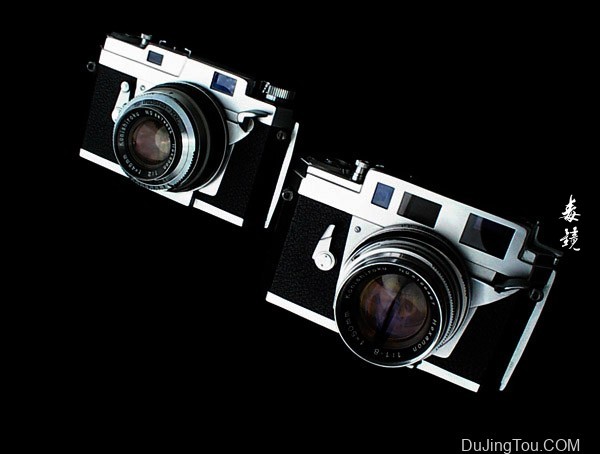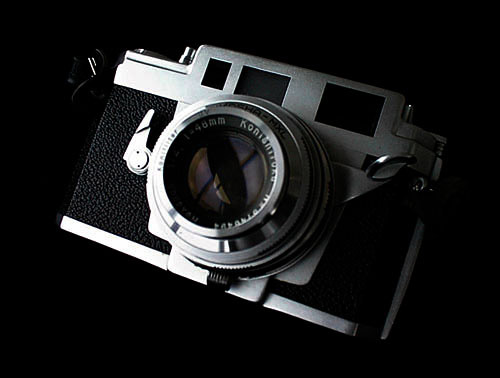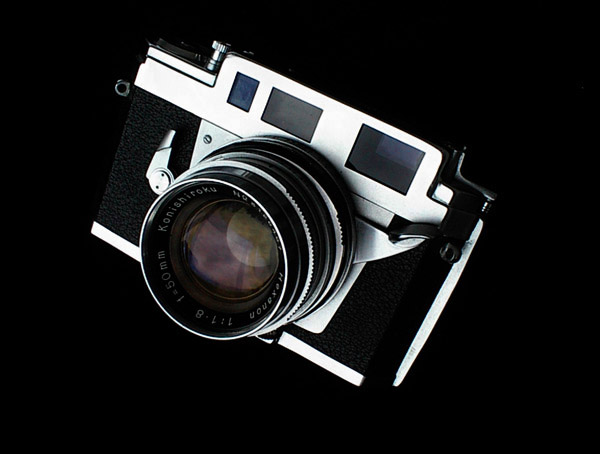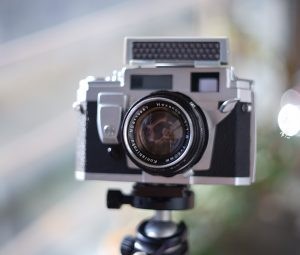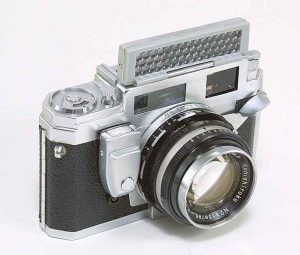| 概述:众所周知,小西六写真工业公司一直是个麻烦制造者。它进入战后市场的第一款产品是柯尼卡标准型(后来称为 I 型),它将天塞式镜头融入叶片快门,并将其添加到取景器中,其清晰度和亮度至今仍具有竞争力。
他们继续生产 I、IL、II 系列、III,然后……这可能是 20 世纪 50 年代最具创新性的两款定焦镜头测距仪。 *您可能会问自己,为什么这些相机在二手市场上的价格要 300 美元。这是一款高价相机。柯尼卡 IIIA 的售价为 1958 年的 129.50 美元(2001 年为 783.31 美元)。随身携带的盒子要多花 12.95 美元(现在是 78.33 美元)。当时, Konica III(由于 IIIA 的推出而降价)的售价为 112 美元(今天为 677.46 美元)。 取景器:Konica IIIA 和 IIIM 最难克服的一点是组合取景器/测距仪的清晰度和亮度及其复杂性。两者都具有带方形点的暖色 1:1 取景器视野(尽管 Pop Photo 评测它具有偏蓝的色调)。 有 50 毫米投影框线,可以移动和收缩以校正视差和靠近时缩小的视野。画面覆盖率在所有距离(线内)为 85%,在所有距离(到线的外边缘)为 95%。 Konica IIIA 是有史以来第一台具有连续视野大小校正的相机(Pop Photo,1958 年)。Konica Pearl IV 6×4.5 测距仪具有类似的取景器布置。截至 1959 年,即 IIIM 推出的那一年,唯一拥有它的其他相机系列是 Graflex Combat Graphic(基本上是 70mm 超级康泰时)。44 年后,徕卡仍然没有它。 IIIM(1959 年)有额外的半画幅系列(稍后会详细介绍)。整体范围/取景器领先竞争对手数光年。 镜头/快门:两款相机均采用基于蔡司 Planar 的镀膜 Hexanon 6 元件镜头。 • IIIa 国内型号(日本和后期交换)配备 Seikosha MXL 快门(35.5mm 滤镜螺纹)中的 48mm f/2 Hexanon 和 EVS 系统。日本国内版本的距离以米为单位;PX(在鞋上标有 (E)xport (P)ermitted 标记)有脚。 美丽 – 带有 48/2 的 Konica IIIA EP 型号。 • IIIa 出口型号(美国)配备 50mm f/1.8 Hexanon(43mm 滤镜螺纹),并装在更大的 Seikosha MXL 快门中。 Konica IIIA 配备 50/1.8 Hexanon • IIIM 型号配备来自 IIIA\ 的 50/1.8 Hexanon。早期型号的快门与 IIIA 相同;其他型号配备 Copal MXV(仅带数字读数)。 两款镜头中,48mm 更紧凑(总直径小 9mm),但其快门难以维修且没有可用零件(最大的故障部件是连接快门释放装置的板)。50/1.8 更清晰,其快门更容易维修。所有快门都以 1-1/500 秒的任何速度同步,并同时执行 M 和 X。我无法理解它们为什么有“V”和“L”模式,因为自拍定时器在相机机身内。 测距仪和限制:测距仪的基座长度约为 50 毫米,对于这些相机所用的固定 48 毫米或 50 毫米镜头来说已经足够了。它是一种重合类型。测距仪由镜头螺旋中的销钉激活。这是一个非常稳定的测距仪系统,很难失调。 有趣的设计特点:IIIA 和 IIIM 都具有前双冲程扳机风,看起来很像蔡司 Tenax II(20 世纪 30 年代的型号)。这种上弦方式可以防止左眼射手戳到自己的眼睛。它还可以让您在不将眼睛从取景器上移开的情况下进行拍摄和上弦。倒片杆折叠在取景器侧面,与 Autoreflex(原始版本)上的倒片杆非常相似。当相机问世时,这是一个非常有争议的功能。 IIIM 有一个特殊的半画幅遮光罩。插入后,它会自动将相机切换为半画幅操作,并且每次拍摄只需上一次卷片。问题是,如果您不购买带有此部件的相机,您将永远找不到(至少不会以低于 IIIM 的价格买到)。由于视角的原因,您最终会得到相当于 75mm f/1.8 镜头的半画幅镜头。 IIIM 还配有一个可翻转的耦合硒测光表。耦合测光表在 1950 年代非常罕见,这可能是最早的耦合测光表之一。测光表读数位于自拍器通常所在的位置。 IIIM 测光表是有史以来第一款采用 FRE(功能电阻元件)技术(即固态曝光计算)的耦合测光表。 IIIM 使用碳电子电阻器来实现这一点,而不是其他火柴针仪表上使用的机械联轴器。 那是 &#$@! EV 锁。您对 EV 系统的第一反应是发疯。放松。如果您的 IIIA (50/1.8) 或 IIIM 有 EV 锁(或者如果在过去 44 年里有人没有解除它),您可以通过按住 ev 环左侧(朝向您)来独立调整光圈。为了保持光圈稳定, |
|
Overview: As we all know, Konishiroku Photo Industrial Co. has always been something of a troublemaker. Its entree into the postwar market was the Konica Standard (later known as the Model I), which incorporated a Tessar-type lens into a leaf shutter and added that to a viewfinder whose clarity and brightness are still competitive today. They went on to make the I, the IL, the II series, the III and then… These are possibly the two most innovative fixed lens rangefinders of the 1950s.
Viewfinders: The hardest thing to get over on the Konica IIIA and IIIM is the clarity and brightness of the combined view/rangefinder and its sophistication. Both feature a warm 1:1 viewfinder field with a square spot (although Pop Photo reviewed it as having a bluish tint). There are 50mm projected framelines which move and shrink to correct both for parallax and for shrinking field as you get closer. Frame coverage is 85% at all distances (inside the lines) and 95% at all distances (to the outside edge of the lines). The Konica IIIA was the first camera ever to have continuous field-size correction (Pop Photo, 1958). The Konica Pearl IV 6×4.5 rangefinder had a similar finder arrangement. As of 1959, the year of the IIIM, the only other camera line to have it was the Graflex Combat Graphic (basically a 70mm uber-Contax). Leica still doesn’t have it, 44 years later. The IIIM (1959) has extra lines for half-frame (more on that later). The overall range/viewfinder was lightyears ahead of the competition. Lens/Shutter: Both cameras feature coated Hexanon 6-element lenses based on the Zeiss Planar.
Of the two lenses, the 48mm is more compact (by 9mm total diameter), but its shutter is difficult to repair and has no available parts (the big failure part is the plate that connects to the shutter release). The 50/1.8 is sharper, and its shutter is easier to have fixed. All shutters synch at any speed from 1-1/500 sec and do both M and X. Why they have “V” and “L” modes is beyond me, since the self-timer is in the body of the camera. Rangefinder and limitations: The rangefinder has about 50mm of base length, more than enough for the fixed 48mm or 50mm lenses these cameras came from. It is a coincident type. The rangefinder is activated by a pin in the lens helicoid. It is a very stable rangefinder system that is very hard to get out of adjustment. Interesting design features: Both the IIIA and the IIIM feature a front, dual-stroke trigger wind which looks a lot like the Zeiss Tenax II (1930s model). This method of winding prevents left-eyed shooters from poking themselves in the eye. It also lets you shoot and wind without taking your eye from the finder. The rewind lever folds into the side of the finder, much like that on the Autoreflex (original verson). This was a very controversial feature when the camera came out. The IIIM has a special half-frame mask. When inserted, it automatically switches the camera for half-frame operation, and you only wind once per shot. The catch is that if you don’t buy a camera with this part, you will never find one (at least not for less than the price of the IIIM). Due to the angle of view, you end up with the equivalent of a 75mm f/1.8 lens for that half-frame. The IIIM also has a flip-up, coupled selenium meter. Coupled meters were very rare back in the 1950s, and this was probably one of the first. The meter readout sits where a self-timer normally would. The IIIM meter was the first-ever coupled meter with FRE (functional resistance element) technology, i.e., solid-state exposure calculation. The IIIM does it with carbon electronic resistors, rather than the mechanical couplings used on other match-needle meters. That &#$@! EV lock. You first impulse with the EV system is to go cracy. Relax. If your IIIA (50/1.8) or IIIM has an EV lock (or if someone hasn’t disengaged it over the last 44 years), you can independently adjust the aperture by holding the left side of the ev ring back (toward you). To keep aperture steady and change shutter, push both sides back and turn. To shuttle between available shutter/aperture combinations (all equalling the same exposure), just turn the EV ring. Odd design limitations: The camera has a hinged back. To open it, you turn a ring on the bottom (like on a Canon RF). But then, instead of pulling down a lever on the side that opens, you push the ring up. This is a very secure system, but if you forget to turn the ring back around, you can have the back pop open suddenly. Also, the accessory shoe is pretty far to the right – probably designed to keep the flash away from the lens axis. You don’t need a separate finder with this camera, so don’t lose any sleep over it. In Operation: It is very, very difficult to find any fixed-lens rangefinder that is as fluid in use and as easy to corral as these two are.
Taken with 48mm f/2 lens Balance/feel: These are both about the size of an M2 and quite heavy, although they feel much smaller due to their thinner body dimension (no need to accommodate a huge Leica-type shutter). Balance is a little back heavy, and the feel is… solid and precise, as if machined from solid brass. What did the critics say in 1958 about the IIIA? “Both Hexanon lenses rank amoung the very finest lenses available today and exhibit the quality of high-grade [read, Leica and Contax] interchangeable optics which cost more than the Konica camera complete with carrying case… Ruggedly precise, extremely well-made body. The smoothness of all operating parts, the strength and accuracy of the hinged camera back and pressure plate system, and the excellent internal baffling have all been incorporated into this new model… one of the finest 35s we have ever encountered” — Pop Photo “What’s New” review, 1958. |


